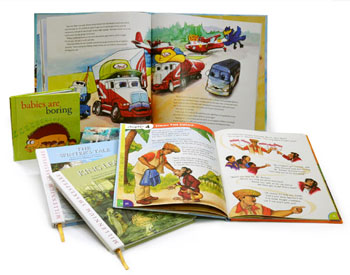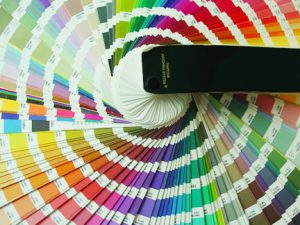 Book endpapers (also called endsheets) are probably the least noticed part of a hardcover book. But the endpapers are literally what hold the pages and the cover together. And they can add value to your book if you use them well.
Book endpapers (also called endsheets) are probably the least noticed part of a hardcover book. But the endpapers are literally what hold the pages and the cover together. And they can add value to your book if you use them well.
If you’re publishing a paperback, take a look at the examples in this article for ideas anyway; you’ll find that the same principles can apply. [Read more…]
 Below you'll find links to all the information about color that’s available on our website,
Below you'll find links to all the information about color that’s available on our website,  Front covers attract and back covers sell—we’ve said it before. At the same time, a book spine should broadcast.
Front covers attract and back covers sell—we’ve said it before. At the same time, a book spine should broadcast. Children’s picture books are fun to design! They’re colorful, full of images, and everything is packed into a small number of words and pages.
Children’s picture books are fun to design! They’re colorful, full of images, and everything is packed into a small number of words and pages. Coffee table books. Are they a blast from the past? No, actually, folks are still publishing them, and you can, too. Do you have an idea for a coffee table book of poetry and photography? About a specific artist or a place you love? About your local history, or something completely different? With good planning and design, your book could become very successful.
Coffee table books. Are they a blast from the past? No, actually, folks are still publishing them, and you can, too. Do you have an idea for a coffee table book of poetry and photography? About a specific artist or a place you love? About your local history, or something completely different? With good planning and design, your book could become very successful.  Will you work with a book illustrator for your book cover and/or pages? If so, you probably have lots of questions! Where can you find a suitable book illustrator? How much should you expect one or more illustrations to cost? Will you own the copyright of the illustrations used in your book? What size, resolution, and format should the digital files be?
Will you work with a book illustrator for your book cover and/or pages? If so, you probably have lots of questions! Where can you find a suitable book illustrator? How much should you expect one or more illustrations to cost? Will you own the copyright of the illustrations used in your book? What size, resolution, and format should the digital files be? Ask any book designer about their collection of reference books and you’ll get a long list of the usual suspects: books about design, typography, layout, and grids; dictionaries and style guides; software manuals; and lots of books and magazines kept for inspiration. But which books are indispensable to a book designer?
Ask any book designer about their collection of reference books and you’ll get a long list of the usual suspects: books about design, typography, layout, and grids; dictionaries and style guides; software manuals; and lots of books and magazines kept for inspiration. But which books are indispensable to a book designer? Need to convert to CMYK in Photoshop? Let’s say you’re designing and typesetting a book with lots of images. You’ve finished laying out all the pages, and your last task is to prepare the images for print. All of your images have either been scanned or photographed, and therefore they are all RGB color (not CMYK color, as required by most offset printers). And most images are JPGs, although you might have a few PNGs too.
Need to convert to CMYK in Photoshop? Let’s say you’re designing and typesetting a book with lots of images. You’ve finished laying out all the pages, and your last task is to prepare the images for print. All of your images have either been scanned or photographed, and therefore they are all RGB color (not CMYK color, as required by most offset printers). And most images are JPGs, although you might have a few PNGs too.
 Do you have a favorite color?
Do you have a favorite color? Are you designing a book cover that’ll become part of a series or boxed set? If so, you’ll need to think ahead! There are a few design considerations to take into account when you plan your book cover design. Not only should your cover design be successful using different title lengths and images, but more importantly, it must create a look or brand that’ll easily identify all future books as being part of the same series. Sound challenging? Don’t worry, we’ve got you covered!
Are you designing a book cover that’ll become part of a series or boxed set? If so, you’ll need to think ahead! There are a few design considerations to take into account when you plan your book cover design. Not only should your cover design be successful using different title lengths and images, but more importantly, it must create a look or brand that’ll easily identify all future books as being part of the same series. Sound challenging? Don’t worry, we’ve got you covered! 
